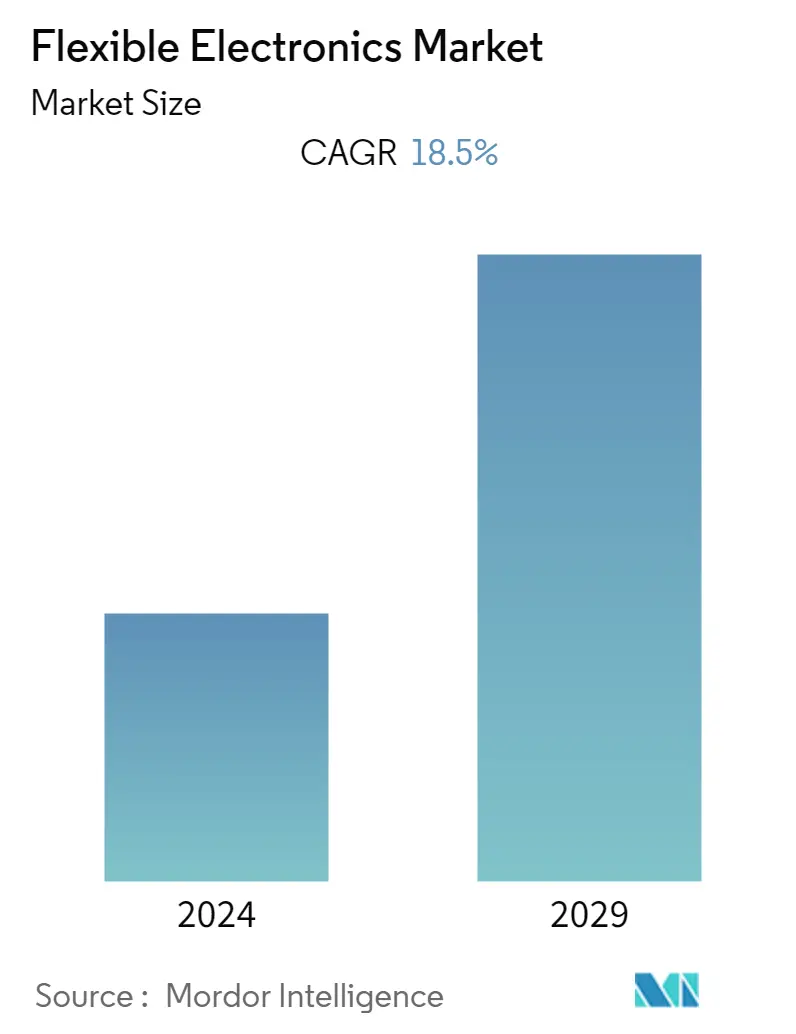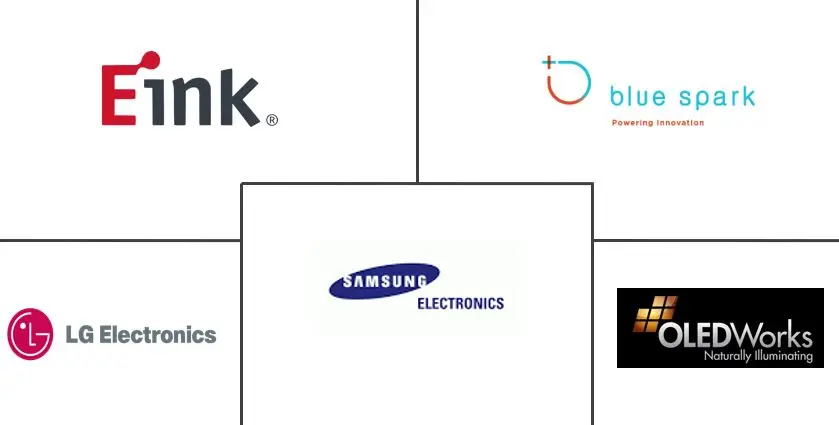Market Size of Flexible Electronics Industry

| Study Period | 2019 - 2029 |
| Base Year For Estimation | 2023 |
| CAGR | 18.50 % |
| Fastest Growing Market | North America |
| Largest Market | Asia Pacific |
| Market Concentration | Low |
Major Players
*Disclaimer: Major Players sorted in no particular order |
Flexible Electronics Market Analysis
The flexible electronics market is expected to register a CAGR of 18.5% during the forecast period. Flexible electronics have gained huge popularity with the growing number of applications, including wearables. Also, the advent of flexible batteries and the growing use of flexible sensors in smart packaging and tracking applications are expected to encourage the development of the flexible electronics market throughout the forecast period.
- Moreover, in March 2021, Toppan Printing developed a flexible thin-film transistor (TFT) that can withstand million bending cycles to a 1 mm radius of curvature and demonstrates advantages for practical application, such as an on/off current ratio of at least 107 with carrier mobility of 10cm2/Vs. This is expected to gain demand for use in foldable smartphones, wearables sensors, smart packaging, medical devices, and more.
- In addition, foldable smartphones are gaining popularity in the market. For instance, in July 2022, Samsung Electronics announced its latest foldable smartphone series. The latest next-generation foldable smartphones, the Galaxy Z Flip 4 and the Galaxy Z Fold 4, were unveiled during the Galaxy Unpacked online event titled "Unfold Your World."
- Furthermore, according to BNP Media, by 2030, electronic components will account for 50% of an automobile's total production cost. Earlier this decade, it was only 30%. Progress in thin, light, and flexible electronics is behind a range of innovative technologies, from curved TVs to glucose-monitoring contact lenses. This can lead to the growth of printable solar cells and flexible screens using organic light-emitting diodes (OLEDs).
- In addition, the advancement of in-mold electronics (IME) and flexible sensors is further expanding the scope of flexible and printed electronics in smart wearable technologies. The growth of wearable devices, especially smart wearable devices, may further expand the market scope over the forecast period. Cisco estimated the number of connected wearables worldwide to surpass 900 million by 2021.
- The COVID-19 outbreak caused major delays for electronic manufacturers, as suppliers based in China struggled to keep factories running at full capacity. Many electronic manufacturers based in the United States or Europe depend on certain components built by suppliers in China. IPC, an electronic equipment trade organization, ran a survey in February 2020, in which 65% of the 150 electronic manufacturers and suppliers who participated reported delays from suppliers due to the spread of COVID-19.
Flexible Electronics Industry Segmentation
The flexible electronics market is segmented by Applications such as Sensing, Lighting, and Display among various End Users such as Consumer Electronics, Automotive, Healthcare, Military and Defense among multiple geographies. The impact of COVID-19 on the market and affected segments are also covered under the scope of the study. Further, the disruption factors impacting the market's growth in the near future have been covered in the study regarding drivers and restraints.
| By Application | |
| Sensing | |
| Lighting | |
| Display | |
| Others Applications |
| By End User Industry | |
| Consumer Electronics | |
| Automotive | |
| Healthcare | |
| Military and Defense | |
| Other End User Industries |
| By Geography | |
| North America | |
| Europe | |
| Asia Pacific | |
| Rest of the World |
Flexible Electronics Market Size Summary
The flexible electronics market is poised for substantial growth, driven by the increasing adoption of flexible electronics in various applications such as wearables, smart packaging, and medical devices. The development of flexible batteries and sensors is further propelling this market expansion. Innovations like Toppan Printing's flexible thin-film transistors, which offer durability and high performance, are expected to enhance the functionality of foldable smartphones and other devices. The rising popularity of foldable smartphones, exemplified by Samsung's Galaxy Z Flip 4 and Galaxy Z Fold 4, underscores the growing demand for flexible electronics. Additionally, the automotive industry's shift towards electronic components, which are becoming a larger portion of production costs, highlights the importance of flexible and printed electronics in modern technology. The advancement of in-mold electronics and flexible sensors is also broadening the application scope in smart wearable technologies, contributing to market growth.
North America is anticipated to experience significant growth in the flexible electronics market, driven by the demand for smart wearables and consumer electronics. The region's robust smartphone and wearable device adoption rates, coupled with interest from the U.S. defense sector in flexible electronics for military applications, are key factors supporting this growth. The market is characterized by fragmentation, with manufacturers focusing on technological innovation and efficiency. Companies like E Ink Holdings Inc., Blue Spark Technologies, and Samsung Electronics Co. Ltd are leading the charge in developing advanced flexible electronics solutions. Recent developments, such as Samsung's skin-attachable OLED display, highlight the potential of flexible electronics in wearable health devices. The ongoing investment in research and development by key market players is expected to further strengthen their positions and drive the market forward.
Flexible Electronics Market Size - Table of Contents
-
1. MARKET INSIGHTS
-
1.1 Market Overview
-
1.2 Industry Attractiveness - Porters Five Forces Analysis
-
1.2.1 Bargaining Power of Suppliers
-
1.2.2 Bargaining Power of Buyers
-
1.2.3 Threat of New Entrants
-
1.2.4 Threat of Substitutes
-
1.2.5 Intensity of Competitive Rivalry
-
-
1.3 Industry Value Chain Analysis
-
1.4 Assessment of Impact of COVID-19 on the Market
-
-
2. MARKET SEGMENTATION
-
2.1 By Application
-
2.1.1 Sensing
-
2.1.2 Lighting
-
2.1.3 Display
-
2.1.4 Others Applications
-
-
2.2 By End User Industry
-
2.2.1 Consumer Electronics
-
2.2.2 Automotive
-
2.2.3 Healthcare
-
2.2.4 Military and Defense
-
2.2.5 Other End User Industries
-
-
2.3 By Geography
-
2.3.1 North America
-
2.3.2 Europe
-
2.3.3 Asia Pacific
-
2.3.4 Rest of the World
-
-
Flexible Electronics Market Size FAQs
What is the current Flexible Electronics Market size?
The Flexible Electronics Market is projected to register a CAGR of 18.5% during the forecast period (2024-2029)
Who are the key players in Flexible Electronics Market?
E Ink Holdings Inc., Blue Spark Technologies, Samsung Electronics Co. Ltd., LG Electronics Inc. and OLEDWorks LLC are the major companies operating in the Flexible Electronics Market.

